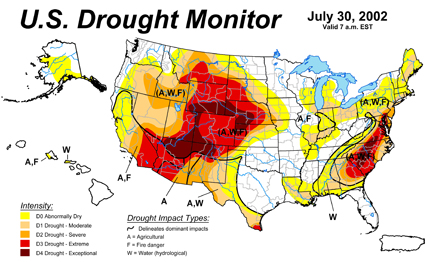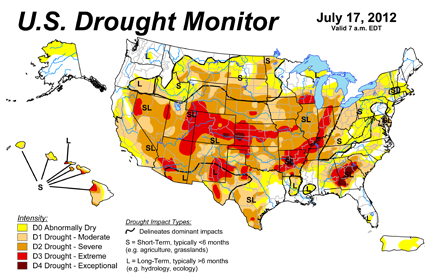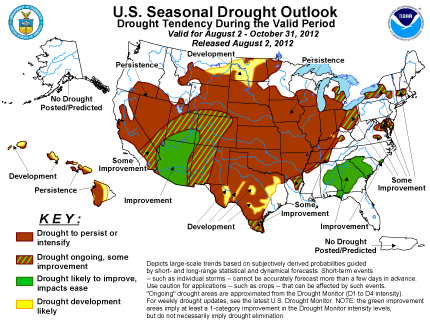The drought of 2002 was very hard on landscaping in Colorado. Plants and lawns were stressed by the hot and dry conditions, and mandatory watering restrictions were put in place across the state. Many of us in the landscaping industry vividly remember these hard times.
Well, the drought is back. Today the USDA predicted a huge drop in corn yields, the latest is a long summer of bad drought news. Below are maps issued by the U.S. Drought Monitor from back in July of 2002 and from July of 2012. As you can see, there are many similarities and much of Colorado is once again in an “extreme drought” situation.

Outlook Does Not Look Good
According to the National Weather Service Climate Prediction Center, the U.S. Seasonal Drought Outlook doe not look promising, although some improvement may occur in southwestern Colorado:
Dryness and drought, exacerbated by above-normal temperatures, have been increasing both in extent and intensity across much of the central and northern U.S. Based upon the July 24 U.S. Drought Monitor, almost 64 percent of the contiguous U.S. was in drought (D1-D4), the highest such value for the U.S. Drought Monitor since its inception in 2000. The last time the lower 48 States had a comparable area of drought (based upon the monthly Palmer Drought Index) was in 1956, according to NCDC.
Across the Southwest, the odds favor an active (wet) southwest monsoon in both the 1- and 3-month precipitation outlooks. As a result, improvement is anticipated across much of Arizona, southern Utah, and southwestern Colorado as the summer monsoon continues.
What Does this Mean for Landscaping in Colorado?
As these maps illustrate, the drought conditions that plagued Colorado in 2002 have resurfaced, and most long-term indicators point to continued drought. The good new is that there are some relatively simple changes and considerations for your landscaping to make it resilient to these conditions.
Some of the lessons we have learned and changes that can be made to your landscaping to better withstand drought include:
- Design new landscapes to be more drought tolerant in the first place. Take a more thoughtful professional approach to your landscape design and consider long term maintenance costs as well as installation costs. Consider hiring a landscape architect or design professional.
- Install the latest irrigation technologies to eliminate wasted water: smart weather based controllers, rain sensors, efficient spray nozzles and drip irrigation, to name a few.
- If lawn areas are not used for foot traffic, and are simply for aesthetics, convert these areas to masses of low growing shrubs, groundcovers, or native grass. You can achieve a similar look with plant massings at the groundplane while reducing water needs and maintenance requirements significantly.
- If you have an older irrigation system, consider having a professional do a water audit, and upgrade old nozzles to new, more efficient ones. If you are stuck with a landscape that requires a lot of water (such as large areas of bluegrass with spray irrigation) you should at least fine tune your sprinkler system. This approach is kind of like putting lipstick on a pig (since your landscape will still “require” the same amount of water to be healthy), however there are some new irrigation nozzles such as the Hunter MP Rotator that can be much more efficient at delivering water where it’s needed. At the very least, these upgrades could be a stopgap measure until the landscape can be renovated.
- Remove large areas of high water use bluegrass and lawns, and replace with native or drought tolerant plantings. A renovation of this sort will make the biggest impact by far. You can covert your landscaping from one that requires a lot of water to remain healthy, to one that requires minimal water and still looks beautiful.
So there you have it. The drought is here to stay. Colorado is a semi-arid climate that will remain dry. While tweaks and minor changes to irrigation systems can provide temporary relief, landscaping that requires a lot of water to stay healthy will always struggle in Colorado and the best approach is to install drought tolerant landscaping from the start, or renovate your landscaping to plantings that require less water.
This is the official blog of Outdoor Design Group, Colorado Landscape Architects. For more information about our business and our services, click here.

